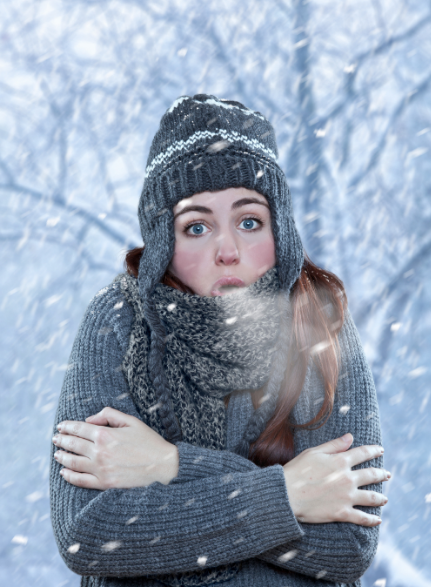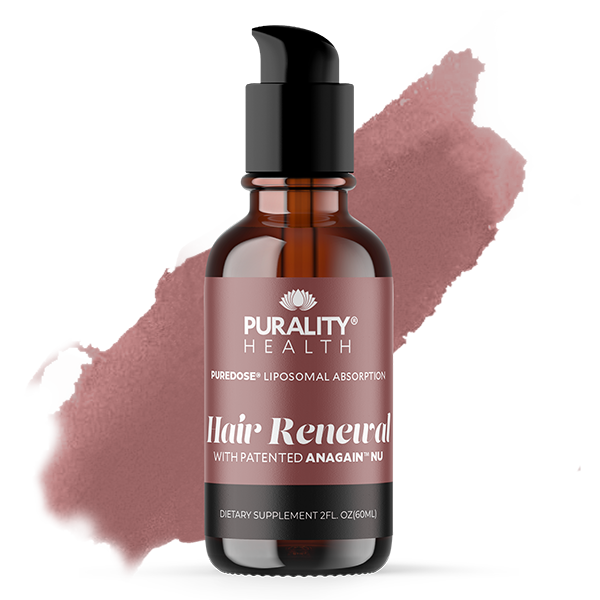Have you ever noticed that your hair seems thinner, flatter, or more brittle in the winter — even if you’re doing everything “right”
You’re not imagining it.
Winter is scientifically the hardest season for hair growth.
Cold air outside… dry, heated air inside… shorter days… more stress… less sunlight… All of these environmental shifts create a perfect storm that slows hair growth, increases shedding, and weakens the hair you do have.
It’s not because you changed your routine. It’s not because you’re aging faster. It’s not because you did anything wrong.
It’s biology.
And the good news? Once you understand why winter interrupts the hair-growth cycle, you can take simple steps to keep your hair fuller, stronger, and healthier all season long.
Here are the 4 major reasons hair growth slows down in winter, and exactly what you can do to fix it.
1. You Get Less Sunlight → Lower Vitamin D → Slower Hair Cycling
 Shorter days. Weaker sunlight. More time inside. All of this means one thing: Your vitamin D levels drop every winter — often dramatically.
Shorter days. Weaker sunlight. More time inside. All of this means one thing: Your vitamin D levels drop every winter — often dramatically.
And that matters for hair more than most people realize.
Vitamin D plays a direct role in your hair’s anagen phase, also known as the growth phase of the hair cycle. When vitamin D levels fall, two things happen:
- The growth phase shortens
- More follicles enter the shedding phase
This is why many people notice more hair in their brush, shower, or on their pillow around December–February.
Even if your diet is great, sunlight is the primary source of vitamin D — and winter simply doesn’t provide enough of it.
How to support winter vitamin D levels:
- Get morning sunlight whenever possible
- Consider vitamin D–rich foods like mushrooms, fortified milk, and salmon
- Be consistent with supplementation (most adults become deficient in winter)
- Support nutrient absorption (we’ll get to that part later)
The bottom line: Winter reduces sunlight… sunlight affects vitamin D… and vitamin D affects hair growth. It’s one of the biggest (and least talked-about) reasons hair growth slows down this time of year.
2. Cold Weather Constricts Blood Vessels → Follicles Get Fewer Nutrients
When temperatures drop, your body goes into protection mode.
To conserve heat, it naturally constricts blood vessels in your skin — including on your scalp. This is great for survival… but not so great for hair growth.
Your hair follicles rely on a steady supply of:
- Oxygen
- Nutrients
- Antioxidants
- Growth-supporting compounds
But in winter, when circulation slows, your follicles get less of everything.
This leads to effects you can see:
- Hair grows more slowly
- Growth looks “stalled”
- Strands look dull or lifeless
- More breakage from weakened fiber
- Less volume and fullness
Even if you’re eating well and taking the right nutrients, those nutrients still have to reach the follicles — and winter makes that harder.
To support scalp circulation in winter:
- Do gentle daily scalp massage
- Keep your scalp warm outdoors (hats help!)
- Move your body to increase overall blood flow
- Reduce hot shower temperatures (which shock the scalp even more)
Winter circulation isn’t something you can fully control — but you can counteract it. It’s one of the key pieces to keeping your growth cycle active when it’s cold out.
3. Indoor Heating Dries Out Hair Roots + Shaft → More Breakage
 Cold air outside isn’t the only winter villain — the warm air inside plays a huge role too.
Cold air outside isn’t the only winter villain — the warm air inside plays a huge role too.
Indoor heating systems strip moisture from the environment, turning your home, office, and even your car into dry-air chambers. That dryness pulls moisture directly from your hair and scalp, leading to:
- Brittle strands
- Split ends
- Breakage mid-shaft
- Dry, tight, or flaky scalp
- A “straw-like” or rough texture
- Hair that looks thinner (because it’s snapping, not growing)
Here’s the sneaky part:
Breakage makes it look like your hair isn’t growing
…even when it actually is.
You’re gaining length — but losing it just as fast from winter-induced damage.
How to protect your hair from dry indoor air:
- Use a humidifier at home (your skin will love it too)
- Avoid extra hot showers that strip the scalp’s natural oils
- Use a leave-in conditioner or light oil on your ends
- Air-dry partially before blow-drying to reduce heat exposure
- Drink more water than you think you need (hydration truly shows up in your hair)
Winter may be cozy, but your hair needs a little help to keep its strength and flexibility this time of year.
4. Holiday + Seasonal Stress Increases Cortisol → More Shedding
Winter isn’t just colder — it’s more stressful.
➡️ Holiday deadlines.
➡️ Travel.
➡️ Money pressure.
➡️ Family intensity.
➡️ Shorter days.
➡️ Less sleep.
➡️ More sugar and caffeine.
Together, these elevate cortisol, your body’s main stress hormone. And cortisol has a direct impact on hair.
High cortisol can:
- Push more follicles prematurely into the telogen (shedding) phase
- Slow down new growth
- Reduce scalp circulation
- Increase inflammation in the hair root
- Disrupt sleep and nutrient absorption — two things hair relies on
This is why many people notice increased shedding around late November, December, and January. It’s not just the weather… It’s the season’s emotional load.
Supporting lower cortisol in winter:
- Prioritize deep sleep
- Get daily movement/light activity
- Reduce caffeine later in the day
- Eat protein at each meal for blood sugar stability
- Use calming practices (breathing, meditation, even warm baths)
Stress-induced shedding can feel scary — but it’s reversible once the root cause is addressed.
Why Nutrient Absorption Matters Most in Winter
Even if you eat well, take supplements, and try your best to support your hair… Winter still creates a hidden problem almost no one talks about:
Your body becomes less efficient at absorbing the nutrients your hair needs.
Here’s why:
- Stress slows digestion
Higher cortisol levels in winter reduce stomach acid and digestive enzyme activity. That means nutrients from food or standard supplements aren’t broken down as effectively. - Cold weather slows circulation
Blood flow is focused on your core organs, not your scalp. So even when nutrients are absorbed, fewer make it to the follicles. - Dry indoor air increases inflammation
A dry scalp is a more reactive scalp, and inflammation around the follicles interferes with nutrient delivery. - Low sunlight impacts multiple nutrient pathways
Vitamin D, B vitamins, and minerals like magnesium and zinc all shift during winter and each one plays a role in hair cycling, thickness, and strength.
The result?
Even when you’re doing everything “right,” your follicles can still struggle to get what they need to stay in the growth phase.
This is why winter is the season when your hair needs direct, highly absorbable nutritional support the most — the type that reaches your follicles no matter what the weather is doing.
And that brings us to the next section…
How Purality Health’s Hair Renewal Helps Keep Hair Growing All Winter
Winter creates the exact conditions that slow hair growth — less sunlight, more stress, weaker circulation, and impaired nutrient absorption.
That’s why this season is the most important time to give your follicles targeted, highly absorbable support.
Purality Health’s Liposomal Hair Renewal was designed for moments just like this.
Here’s how it helps keep your hair growing strong all winter long:
✓ Contains AnaGain™ Nu — a clinically studied pea sprout extract
Shown to support visibly thicker, fuller-looking hair by helping extend the growth phase and reduce excess shedding.
✓ Powerful biotin + botanical blend for strength + resilience
Biotin helps reinforce the structure of each hair strand from within, reducing breakage (a major winter issue). Additional plant nutrients support scalp nourishment and stronger roots.
✓ Liposomal micelle delivery = next-level absorption
This is the biggest reason Hair Renewal is so effective: It bypasses the absorption challenges winter creates by protecting the nutrients and delivering them directly into the bloodstream where they can reach the follicles.
No matter the weather. No matter the stress. No matter the season.
Your follicles get what they need to stay active, nourished, and ready to grow.
✓ Designed for consistency + real results
Many users notice fuller-looking roots, less shedding, and healthier-feeling hair after 30–60 days of daily use.
And since winter is when your hair needs the most support, this is the perfect time to start.
 Your Hair Can Thrive This Winter
Your Hair Can Thrive This Winter
Winter may be a tough season… but it doesn’t have to be the season your hair struggles.
Once you understand why hair growth slows — less sunlight, dry air, cold weather, holiday stress — you can take simple steps to protect your follicles and keep your hair looking fuller, stronger, and healthier.
With the right nutrition, a little scalp care, and a formula designed to overcome winter’s absorption challenges, your hair can absolutely thrive this season.
And that’s exactly why so many people turn to Liposomal Hair Renewal this time of year — to give their follicles the support winter takes away.
☑️ Stronger roots.
☑️ Less shedding.
☑️ More growth.
☑️ More confidence.
>>> Click here to claim a special offer for blog readers and to have the BEST hair this winter
